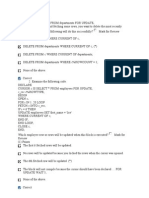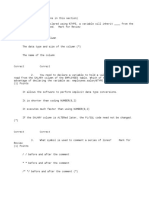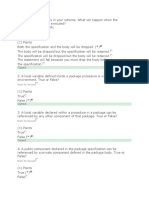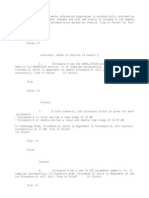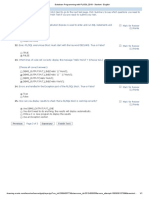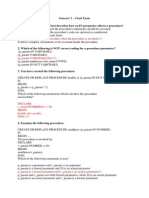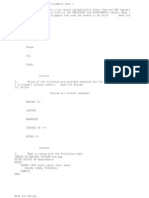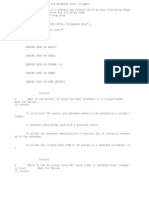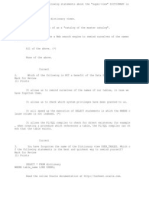Using Transaction Control Statements
Uploaded by
Catalina AchimUsing Transaction Control Statements
Uploaded by
Catalina AchimTest: Quiz: Using Transaction Control Statements 1. In a PL/SQL block, where can you code a COMMIT statement?
Review (1) Points Mark for
In any section of the block: Declaration, Executable, or Exception. Only the Executable section. In the Executable and/or the Exception sections. (*) Nowhere; the COMMIT statement must be outside the block.
Correct 2. How many transactions are in the following block? BEGIN INSERT INTO countries (country_id, country_name) VALUES ('XA', 'Xanadu'); INSERT INTO countries (country_id, country_name) VALUES ('NV', 'Neverland'); UPDATE countries SET country_name='Deutchland' WHERE country_id='DE'; UPDATE countries SET region_id=1 WHERE country_name LIKE '%stan'; END; How many transactions are shown above? Mark for Review (1) Points Four; each DML is a separate transaction Two; both the INSERTs are one transaction and both the UPDATEs are a sec ond transaction. It depends on how many rows are updated - there will be a separate trans action for each row. One (*)
Correct 3. How many INSERTs can you have in one transaction? (1) Points Mark for Review
One As many as you want until you do a COMMIT or ROLLBACK. (*) As many as you can execute before the database does an AUTOSAVE. As many as you want until a different DML statement (UPDATE, DELETE or M ERGE) is executed.
Correct 4. Examine the following code: BEGIN INSERT INTO animals VALUES ('aa','aardvarks'); SAVEPOINT sp_1; INSERT INTO animals VALUES ('bb','big birds'); SAVEPOINT sp_2; ROLLBACK TO sp_1; INSERT INTO animals VALUES ('cc','cool cats'); COMMIT; END; Which row(s) will be in the ANIMALS table after this block is executed? Mark for Review (1) Points cool cats big birds and cool cats aardvaarks and cool cats (*) aardvaarks, big birds and cool cats
Correct
You might also like
- 1z0-148.exam.47q: Website: VCE To PDF Converter: Facebook: TwitterNo ratings yet1z0-148.exam.47q: Website: VCE To PDF Converter: Facebook: Twitter55 pages
- Quiz1 - Conditional Control If StatementsNo ratings yetQuiz1 - Conditional Control If Statements5 pages
- DWPD GTU Study Material E-Notes Unit-5 22092020071825AMNo ratings yetDWPD GTU Study Material E-Notes Unit-5 22092020071825AM16 pages
- Section 5 - Stored Procedures / FunctionsNo ratings yetSection 5 - Stored Procedures / Functions7 pages
- DAC - EANDC - QB - Question Bank For DBTNo ratings yetDAC - EANDC - QB - Question Bank For DBT23 pages
- Creating DDL and Database Event TriggersNo ratings yetCreating DDL and Database Event Triggers4 pages
- Using Invoker's Rights and Autonomous TransactionsNo ratings yetUsing Invoker's Rights and Autonomous Transactions3 pages

